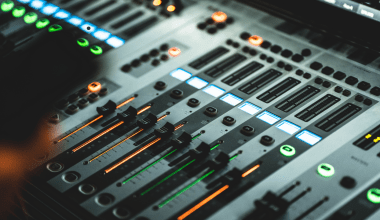Creating a music album is an exhilarating journey that combines creativity, technical skills, and a strategic approach. Whether you’re an aspiring artist or a seasoned musician, understanding the process of how to create a music album will help you craft a cohesive and compelling work of art. This comprehensive guide covers every aspect of album creation, from the initial concept to the final release, ensuring your music reaches its full potential.
1. Conceptualize Your Album
The foundation of how to create a music album lies in its concept. The concept defines the direction of your album and unifies all the songs under a common theme or idea. This phase requires deep introspection and creativity, as it sets the tone for your entire project.
Steps to Develop Your Concept:
- Identify Your Vision: What message or story do you want to convey through your album? Your vision could be inspired by personal experiences, social issues, or purely artistic ideas.
- Research and Inspiration: Study other concept albums and explore different themes. Inspiration can come from literature, films, art, or even daily life.
- Define the Genre: Your concept may influence the genre of music you choose. Whether it’s rock, pop, hip-hop, or classical, make sure the genre aligns with your concept.
- Create a Mood Board: A visual mood board with images, colors, and words that reflect your concept can help keep you focused during the creative process.
2. Songwriting and Composition
Songwriting is the heart of how to create a music album. This is where your ideas are transformed into melodies, harmonies, and lyrics. Writing songs that are not only catchy but also resonate with your audience is crucial.
Songwriting Techniques:
- Start with the Hook: The hook is the catchiest part of the song, often the chorus. Starting with a strong hook can help you build the rest of the song around it.
- Lyrics Matter: Your lyrics should reflect the theme of your album. Be honest and authentic in your writing, as listeners often connect with genuine emotions.
- Melodic Structure: Experiment with different melodic structures. A strong melody is key to making your songs memorable.
- Collaboration: Collaborating with other songwriters can bring fresh ideas and perspectives to your music. Don’t hesitate to seek input from others.
Composition Considerations:
- Chord Progressions: Chord progressions lay the foundation for your songs. Choose progressions that complement the mood and style of each track.
- Instrumentation: Decide on the instruments you’ll use. The right instrumentation can enhance the emotional impact of your songs.
- Tempo and Rhythm: The tempo and rhythm should align with the overall vibe of your album. Faster tempos might energize, while slower tempos can evoke introspection.
3. Pre-Production Planning
Before stepping into the studio, pre-production planning is essential. This stage of how to create a music album involves preparing all the elements needed for a smooth recording process.
Key Elements of Pre-Production:
- Song Selection: Choose the final set of songs that will make it to the album. Not every song you write will fit the theme or quality standards, so be selective.
- Create Demos: Record basic demos of your songs. These rough recordings will help you and your producer understand the direction of each track.
- Budget Planning: Album production can be costly. Factor in expenses such as studio time, session musicians, equipment rentals, mixing, mastering, and marketing.
- Assemble Your Team: If you’re working with a band or session musicians, ensure everyone is clear about their roles and responsibilities.
4. Recording
Recording is where your vision starts to take tangible form. This stage of how to create a music album requires careful attention to detail to capture the best possible performances.
Tips for a Successful Recording Session:
- Choose the Right Studio: The choice of studio can greatly influence the quality of your recordings. Look for a studio with good acoustics, professional equipment, and an experienced sound engineer.
- Prepare Your Instruments: Ensure that all instruments are in perfect condition. This includes tuning guitars, checking drum skins, and maintaining any electronic equipment.
- Vocal Warm-Ups: Vocalists should do proper warm-ups before recording to prevent strain and ensure the best vocal performance.
- Experiment with Sounds: Don’t be afraid to experiment with different sounds, effects, and recording techniques. Sometimes, the most unexpected ideas lead to the best results.
- Record in Layers: Consider recording instruments and vocals in layers. This allows for greater control during mixing and can add depth to your sound.
5. Mixing and Mastering
Once the recording phase is complete, the next step in how to create a music album is mixing and mastering. These processes are vital for creating a polished, professional sound.
Mixing Process:
- Balance and Clarity: Mixing involves balancing the levels of all the recorded tracks. Each element, from vocals to instruments, must be clearly heard without overpowering others.
- Equalization (EQ): EQ is used to adjust the frequency balance of each track. This ensures that the bass, midrange, and treble are all well-balanced.
- Reverb and Delay: Adding reverb and delay can create a sense of space and depth. However, these effects should be used sparingly to avoid muddling the sound.
- Automation: Use automation to adjust the levels and effects throughout the song dynamically. This helps maintain interest and enhances the emotional impact.
Mastering Process:
- Consistency: Mastering ensures that all tracks on the album have a consistent sound and volume level. This is crucial for a cohesive listening experience.
- Compression: Compression is used to control the dynamic range of the tracks, making the quieter parts louder and the louder parts quieter, which creates a more balanced sound.
- Final Touches: The mastering engineer may add final touches, such as slight EQ adjustments, stereo enhancement, and limiting, to ensure the album sounds great on all playback systems.
- Format Preparation: The mastered tracks are then prepared for distribution in various formats, including digital files, CDs, and vinyl.
6. Album Artwork and Visuals
The visual aspect of your album is just as important as the music itself. The album cover is often the first thing listeners see, so it must make a strong impression.
Designing the Album Cover:
- Hire a Professional: If possible, hire a professional graphic designer or illustrator to create your album cover. They can help bring your concept to life visually.
- Incorporate the Theme: The album artwork should reflect the theme and mood of the music. Use colors, imagery, and typography that align with your album’s concept.
- Consider Different Formats: If you’re releasing your album in multiple formats (digital, CD, vinyl), ensure the artwork looks good in all sizes and layouts.
- Include Liner Notes: Liner notes can provide additional context to your album, such as lyrics, credits, and thank-you notes. These can be included in the CD booklet or as a digital PDF.
Visual Branding:
- Music Videos: Music videos are powerful tools for visual storytelling. Consider creating videos for your singles to complement the album’s narrative.
- Photography: High-quality photos of you or your band can be used for promotional purposes and within the album packaging.
- Website and Social Media: Ensure your website and social media profiles reflect the visual style of your album. Consistency in branding helps build a recognizable image.
7. Marketing and Promotion
Marketing is a crucial element of how to create a music album. Without effective promotion, even the best albums can go unnoticed.
Marketing Strategies:
- Social Media Campaigns: Launch social media campaigns leading up to your album release. Share teasers, behind-the-scenes content, and updates to keep your audience engaged.
- Email Newsletters: Build an email list and send newsletters to your subscribers with exclusive content, such as early access to songs, special offers, and updates.
- Collaborate with Influencers: Partner with influencers, bloggers, or YouTubers who can help promote your album to their audience.
- Radio and Podcasts: Get your music played on radio stations and podcasts. Interviews and live sessions can also help you connect with listeners.
- Pre-Order and Pre-Save Campaigns: Offer pre-orders for physical copies and pre-save options for digital platforms. This helps build anticipation and secures early sales.
8. Distribution Channels
Choosing the right distribution channels is essential in how to create a music album. You want to ensure that your album is available to as many listeners as possible.
Digital Distribution:
- Streaming Services: Distribute your music to major streaming platforms like Spotify, Apple Music, Amazon Music, and YouTube Music. Use a digital distribution service like Deliver My Tune, DistroKid, or TuneCore to manage this.
- Bandcamp and SoundCloud: These platforms allow you to sell your music directly to fans and offer more control over pricing and distribution.
- Digital Downloads: Make your album available for purchase on platforms like iTunes, Google Play, and Amazon.
Physical Distribution:
- CDs and Vinyl: If your audience appreciates physical formats, consider producing CDs or vinyl records. These can be sold at live shows, through your website, or in retail stores.
- Merchandise Bundles: Create bundles that include your album along with merchandise like t-shirts, posters, or stickers. This can increase the perceived value and boost sales.
9. Release Strategies and Post-Release Promotion
Releasing your album is a significant milestone in the journey of how to create a music album. However, the work doesn’t stop once your album is out in the world. You need to strategically plan your release and continue promoting your album even after its launch to maximize its impact.
Strategic Release Date:
- Timing Matters: Choose a release date that aligns with your audience’s behavior and the industry calendar. Avoid releasing your album during major holidays or when other major artists are dropping their albums to avoid competition.
- Seasonal Themes: If your album has a seasonal theme (e.g., a summer or winter vibe), align the release with that season to resonate more with your audience.
Album Launch Event:
- Host a Listening Party: A listening party, either virtual or in-person, can generate excitement around your album. Invite fans, friends, and industry contacts to preview your album.
- Live Performances: Organize a live performance or a mini-tour around the release date. Performing your new songs live can create a deeper connection with your audience and drive album sales.
Leverage Digital Platforms:
- Exclusive Content: Release exclusive content, such as bonus tracks, acoustic versions, or remixes, to keep your audience engaged after the initial release.
- Social Media Contests: Engage your fans with social media contests. For example, ask them to share their favorite track from the album, create fan art, or remix one of your songs.
- Analytics and Feedback: Use analytics tools on platforms like Spotify for Artists or Apple Music for Artists to monitor your album’s performance. Pay attention to which songs are performing well and use this data to plan further promotion.
Post-Release Engagement:
- Q&A Sessions: Host Q&A sessions on Instagram Live, Facebook Live, or YouTube to discuss the making of the album, the stories behind the songs, and your creative process.
- Fan Interaction: Engage with your fans by responding to comments, messages, and fan content. Building a community around your music can lead to a more loyal and supportive fanbase.
- Content Series: Create a series of content pieces, such as behind-the-scenes videos, lyric breakdowns, or interviews with collaborators, to keep the album promotion going over several weeks or months.
10. Analyze, Reflect, and Plan for the Future
The final phase of how to create a music album is analyzing its success and planning your next steps. This phase is crucial for your growth as an artist and for refining your future projects.
Analyze the Album’s Performance:
- Sales and Streaming Data: Review the sales and streaming numbers across different platforms. Identify which tracks performed the best and where most of your listeners are coming from.
- Fan Feedback: Gather feedback from your fans through social media, email newsletters, or direct surveys. Understanding what resonated with your audience and what didn’t can inform your future projects.
- Critical Reviews: Take note of reviews from music critics and bloggers. While it’s important to stay true to your vision, constructive criticism can provide valuable insights.
Reflect on the Process:
- What Worked Well: Reflect on the parts of the album creation process that went smoothly. Did certain songwriting techniques, recording methods, or promotional strategies yield better results?
- Challenges and Solutions: Identify the challenges you faced during the creation of the album. What were the roadblocks, and how did you overcome them? Use these insights to improve your workflow.
- Personal Growth: Consider how the process of creating this album has contributed to your growth as an artist. Have you discovered new strengths, or perhaps new areas to develop further?
Plan Your Next Steps:
- Future Projects: Based on the success and learnings from this album, start planning your next project. Whether it’s a new album, an EP, or a series of singles, use the momentum you’ve built to keep moving forward.
- Collaborations: Explore potential collaborations with other artists, producers, or songwriters. Collaborative projects can bring fresh energy and new perspectives to your music.
- Long-Term Goals: Set long-term goals for your music career. These could include reaching specific streaming milestones, touring, signing with a label, or expanding into new markets.
11. The Importance of Consistency and Persistence
Creating a successful music album is not just about a single project; it’s about building a career. The process of how to create a music album teaches valuable lessons in consistency, persistence, and resilience.
Consistency in Content Creation:
- Regular Releases: To maintain and grow your fanbase, consider releasing new music regularly. Whether it’s singles, EPs, or albums, staying active keeps you in the minds of your listeners.
- Engaging with Fans: Consistently engage with your fans through social media, live streams, and email newsletters. Keep them updated on your journey and upcoming projects.
Persistence Through Challenges:
- Overcoming Setbacks: The journey to creating an album is filled with challenges, from creative blocks to technical issues. Persistence is key to overcoming these obstacles and completing your project.
- Learning from Failure: Not every album or song will be a hit, and that’s okay. Each project is a learning opportunity. Take the lessons from any setbacks and apply them to your future work.
Building a Legacy:
- Long-Term Vision: Think about the legacy you want to create as an artist. Each album is a chapter in your story. What do you want your music to represent in the long run?
- Impact on the Industry: Consider how your music can contribute to the industry. Can you innovate in a way that influences other artists or shapes new trends?
Conclusion
Creating a music album is a monumental achievement that requires dedication, creativity, and strategic planning. By following the steps outlined in this guide on how to create a music album, you can navigate the complex process of album production with confidence. From conceptualization and songwriting to recording, mixing, and promotion, each stage plays a vital role in bringing your vision to life.
Remember, the key to a successful album lies not only in the quality of the music but also in how you connect with your audience and promote your work. Stay true to your artistic vision, be open to learning from each project, and keep pushing the boundaries of your creativity. With persistence and passion, your album can make a lasting impact in the world of music.
For further reading, explore these related articles:
For additional resources on music marketing and distribution, visit Deliver My Tune.






